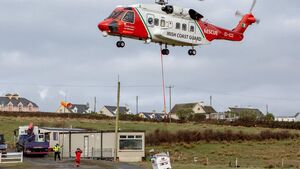Perfect storm for highlighting State's failings

The Irish Coast Guard at Spanish Point in Co Clare prepare to lift a generator as an alternative power supply and fuel to Inismaan in the Aran Islands as Uisce Éireann worked to restore the water supply there in the wake of Storm Éowyn. Picture: Press 22
It is now well over two weeks since the fearsome Storm Éowyn came to our shores and left a trail of destruction behind.
Incredibly, some people are still without power and tens of thousands more only had their power restored inside the last week.
Hindsight is 20:20 and while you would have a little (not a lot) of sympathy for the Government for the unforeseen extent of the damage of the storm, what Storm Éowyn has done is highlight so many problems with how we do business in Ireland.
We’ve had bad storms before. Indeed, where I live in Achill, Storm Darragh caused more structural damage than Éowyn. However, most storms before Éowyn, Darragh included, weakened as they hit landfall and impacted severely on only parts of the coast.
Éowyn was different. The coast, usually a buffer for those inland, was no barrier to its ferocity and the breadth of the storm meant the extent of its damage was so much greater. Witness record numbers of power outages (over 768,000 electricity customers without power), fallen ESB poles and trees, and the long wait for far too many people to get their power back. For comparison, in 2017, Storm Ophelia had 385,000 customers without power while Storm Ellen in 2020 caused 194,000 outages.
It was a game-changer of a storm. The Government might have been able to point to its rarity now but that’s a card you can play only once. Particularly when Met Éireann has warned that major weather events like Éowyn are likely to become more frequent in the years ahead. As Minister Dara Calleary conceded: "Whilst Éowyn was unprecedented, it is now the precedent."
The Government is under the microscope for how it reacted to this storm and what proactive steps it will take for future incidences. It was slow to accept help from Europe with crews coming in from the UK and as far away as Austria and Finland while the roll-out of emergency centres for those without power was also tediously slow and, for the most part, people relied on community organisations like the GAA to plug this gap.
There is also the optics of how the Government has responded. It has been under fire for adjourning the Dáil for a week right as the storm hit. I am not sure a fractious Dáil debate would have been overly productive. However, while that is an argument the Government has made, it would have stood up much stronger if people were of the view that Ministers and TDs were responding adequately to the storm fall-out. However, the farcical debate over Dáil speaking rights seems to have engaged the political classes far too much at a time when so many of the electorate were - and are - crying out for help.
There is a debate to be had on the divisive issue of the use of fossil fuels and traditional fires in homes, something which has been phased out in many new houses. A warm turf or coal fire and a gas cooker were invaluable during power outages. It is a fractious debate with too much emotion and not enough rational discussion but the storm did highlight that while there is a significant environmental element, their utility is substantial when the electricity is out.
The storm will undoubtedly lead to a major discussion on the resilience of our current power network. As the historian Diarmuid Ferriter pointed out in , the ESB poles that traverse our countryside were seen as a symbol of modernity with the roll-out of rural electrification in the 1950s, now they are "becoming vulnerable beacons of outdatedness".
While there has been a lot of hyperbole about trees being the problem, the reality is the ESB poles are more problematic. Trees, lest we forget, are vital to our environment and our future.
Putting electricity cables underground has been mentioned. It is easier said than done. Some estimates have the cost of undergrounding our entire network at a mouth-watering €100 billion. As reporter Jack McCarron pointed out on RTÉ's last week, 84%of our electricity network still runs above ground.
The well-worn trope of this being a consequence of rural living has been trotted out in recent weeks. One-off housing does, by its very nature, require more electricity lines and greater expense, above or underground. But, as McCarron pointed out, countries like Sweden and Finland have lower population densities than ours yet Sweden has just 60% of its network overground and Finland only 57%.
While rural Ireland is an easy target, maybe we should be exploring the inefficiencies of various utilities and arms of the state in the provision of such services. High Street in Westport was dug out twice within weeks in recent months for separate works that could have easily been done at the same time to cut costs and reduce the inconvenience to people. It is but one of countless examples of the lack of joined-up thinking in this regard in Ireland.
Right now in Achill, broadband cabling is being installed. Some overground but much of it underground. How long until the same roads need to be dug up again?
With so many services now privatised, the ability for them to work together and reduce the cost to the state has greatly diminished. It wasn’t great in the first place when they were semi-state or fully an arm of the state.
You reap what you sow.
Going back to our Scandinavian friends, they hold to account electricity providers with regard to their response to power cuts. In Finland, you are entitled to compensation if you are without power for more than 12 hours. As every day passes, that compensation rises. It is a great inducement to the electricity providers to act with haste and adequate resources.
The ESB crews have done trojan work since Storm Éowyn, as always, but resources are not what they could be.
Denmark has very clear, legislative framework on ‘security of supply’ backed up by investment in the network. Their security of supply is above 99.99%, with undergrounding of cables a key part of this.
Yet in Ireland, we have heard Paddy Byrne, ESB CEO, say that the cleanup from Éowyn will likely lead to an increased cost for consumers. However, Daragh Cassidy, head of communications with utility price comparison site Bonkers.ie, made the very salient point that the "ESB is a highly profitable company".
“This isn’t the first time we’ve had a storm. Although the damage was extensive one would hope that as a profitable company, the ESB would find itself able to pay for this stuff from its own reserves,” Mr Cassidy said.
Profits at the ESB jumped by more than 33% to €868 million in 2023. The resources to be flexible and to invest in their network are there.
Change from the ESB and the state itself in how we prepare for future inevitable storms like Éowyn is essential. Can we learn from this or will history repeat itself?






